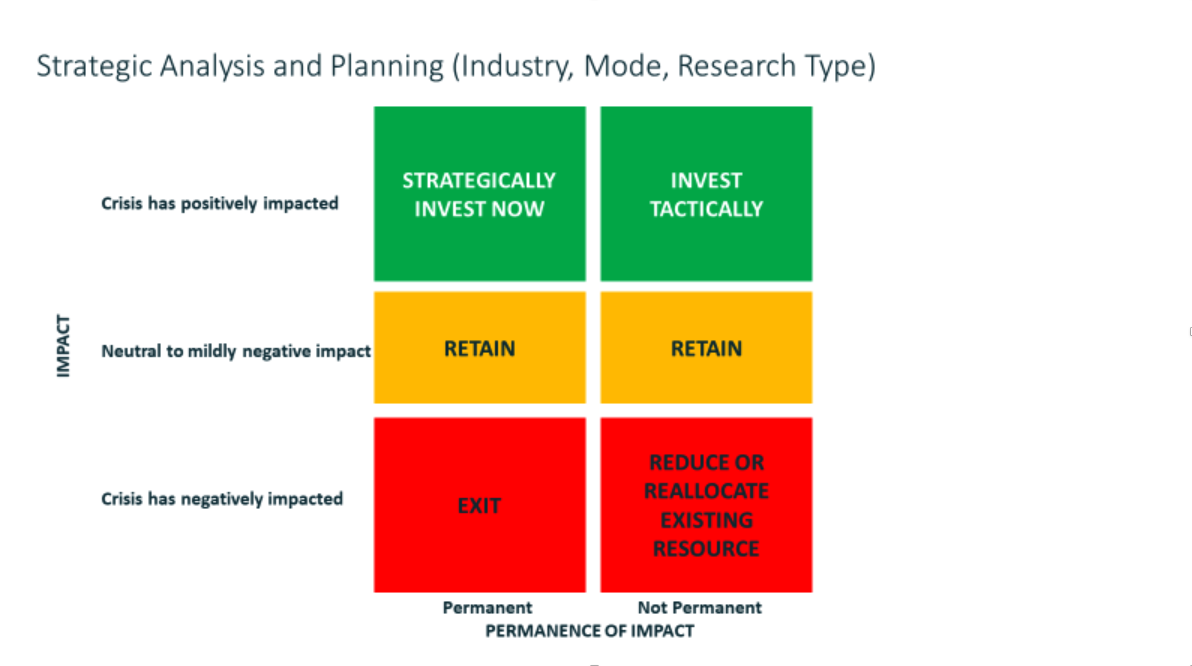“The ultimate measure of a man is not where he stands in moments of comfort, but where he stands at times of challenge and controversy”
Martin Luther King, Jr.
Substitute the word “leader” (of whatever gender) and add the word “uncertainty” and these words perfectly reflect our world today. The times are indeed challenging (highly so), there is controversy over how to deal with them and, above all, there is great uncertainty. Nobody right now, not even the best scientists and statisticians, really knows how the COVID-19 crisis will play out nor what the world will look like when things return to “normal”. And yet, as leaders we still have to lead. We have to navigate our way through this storm and we have to prepare for a future that is, at best, hazy. Whether you are a leader in a corporate insights function, an insights supplier or in the research and analytics supply chain, the situation is the same.
But how to lead?
In the face of a crisis such as this, it is not unnatural for leaders at first to feel helpless – something that none of us likes to feel. Helplessness can lead to depression and intimations of failure. We are none of us immune to this – even Winston Churchill had bouts of severe depression (what he called ‘Black Dog’) during WWII. The first thing to do is to accept these feelings as normal and human. Once you understand that you are not super-human (and that nobody expects you to be), you can then start to build a framework of how you and your team will think and act through and beyond the crisis. There are three key elements to this:
- How you yourself think and act towards your team as their leader
- The tactics you will need to deploy to keep the ship afloat during the storm
- The strategy you will develop to position the team for success once the ‘new’ world emerges.
You as a Leader
Bill Guerin, Managing Partner of Catalytics Performance Consulting and a noted Team Effectiveness teacher, coach and mentor, has developed a framework of eleven tenets by which to lead in a crisis. The first, and perhaps most important, is to lead from the inside out. By this he means to align your actions with your own personal values and what you stand for. Assuming your values to be positive ones (and if they are not, you are probably not a genuine leader), this will allow you to clarify your priorities and telegraph them to the team through your daily actions. As an example, if one of your key values is to protect and promote the wellbeing of those in your team, then you will actively seek ways to mitigate the financial and mental damage that could harm them as a result of the crisis. You might decide not to lay people off but instead to spread the burden so that seniors accept greater sacrifices than those further down the chain.
How you live your values in a time like this will not only affect your team’s cohesion and morale, but also give them purpose.
Beyond this, Guerin establishes ten further tenets:
- Increase your visibility – heighten your leadership profile and accessibility, and establish a comprehensive communications plan that addresses all key stakeholders
- Play to your strengths – understand and leverage your personal strengths and utilize the strengths of others
- Keep it real – define the current reality in clear and objective terms, and make distinctions between what is known and what is not known
- Rally the troops – identify and champion an immediate shared objective to provide short-term clarity and inspire commitment and action
- Work smarter – focus actions on challenges that can be controlled or influenced, don’t confuse activity with effectiveness
- Plan the work – establish understanding and alignment on plans, priorities and expectations
- Remove obstacles – promote a climate where everyone is encouraged and equipped to contribute their highest value
- Work the plan – develop a cadence of accountability and real-time feedback to measure, monitor and report progress
- Prepare to pivot – review and assess the effectiveness of strategies and actions, and redirect as required
- Position for recovery – dedicate time and resources to prepare the organization to recover as quickly and fully as possible post-crisis.
Tactical Agility and Strategic Flexibility
We are in the business of evidence. As Guerin suggests, we need to be clear about what we know and don’t know. But that does not mean that we shouldn’t seek out all the knowledge possible and then try to translate that knowledge into foresight. Right now, there is plenty of evidence being collected about changes in consumer behaviour and emotions, many of which are being curated within evidence repositories by both ESOMAR and national associations. There are economic data as well as information about what ‘new normal’ looks like in countries that are ahead of our own in emerging on the other side of crisis – for example, S. Korea. What do they suggest for the future?
Then there is the age old but all too often ignored human capability of listening. What are clients saying? How are they planning for ‘new normal’? What do they need most now? What you hear might surprise you. On current evidence, it would seem that many clients may be cutting back on all research that is non-essential right now but are actively planning for a tsunami of work designed to understand the new landscape once the crisis is over.
By collating evidence and applying a modicum of judgement, it is entirely possible not only to work out how various industries are being affected and how permanent those effects may be. Similarly, the same evidence may be collected about how different research modes are experiencing the crisis (for example, less face to face qualitative and more digital; more reliance on data analytics, less on surveys) and how permanent that may be; and about how different research methodologies may evolve – will we see more digital ethnography for example?
Assess each of these and then adjust your strategies and tactics accordingly. If, for example, you are seeing some of your work (whether defined by industry, mode or method) negatively affected, ask yourself how permanent you think this will be. If permanent, you may elect strategically to exit that part of your business. If not permanent, then tactically you can shift resources temporarily to areas of business that are experiencing more robustness. The framework for deciding what to do and where to focus tactically and strategically can be represented like this:

The right-hand side of the framework dictates tactics – how you allocate your existing resources, conserve cash and seek shorter-term business opportunities. The left-hand side relates to what you do and what you invest in strategically. This will inform where (carefully) you will deploy both capital and training, who you will seek to hire (either now or down the road) and how you will position the business going forward.
The Measure of a Leader
Ultimately, leadership in times of crisis boils down to how we ourselves act, the values that guide us, the evidence we gather, the way in which we observe and listen, the foresight we can fashion, and the clarity and simplicity with which we communicate.
In sum, the same as good leadership in times of normality and comfort, only more so.



1 comment
This is very helpful list of leadership considerations. With the constant focus on day-to-day stock prices, I noticed many leaders trapped in the immediate management of urgent (but less important) priorities to boost their stock prices. I wonder if the pandemic will bring a more long-term focus to stock prices, cause leaders to prioritize (by necessity) towards long-term matters? Will that be an easy change for them to make?